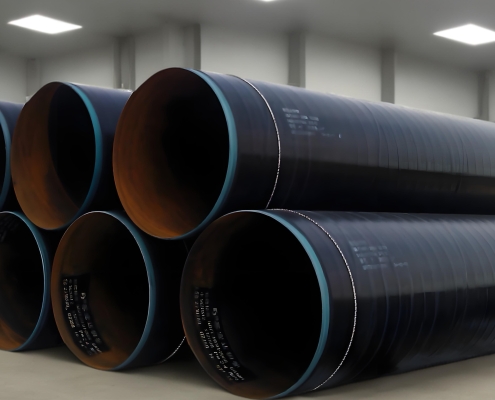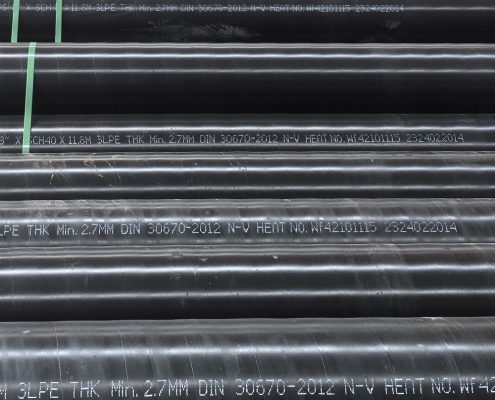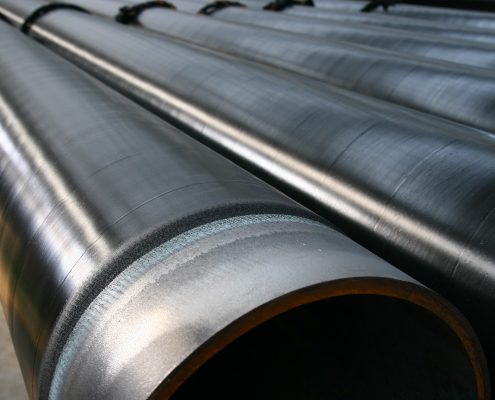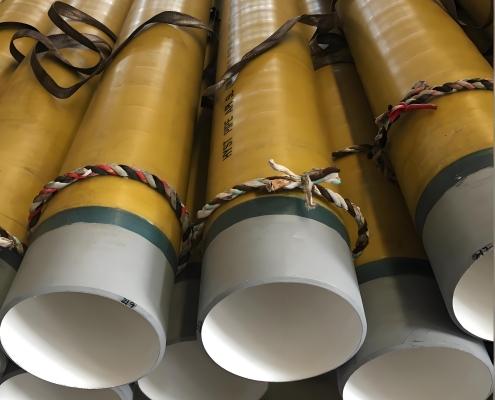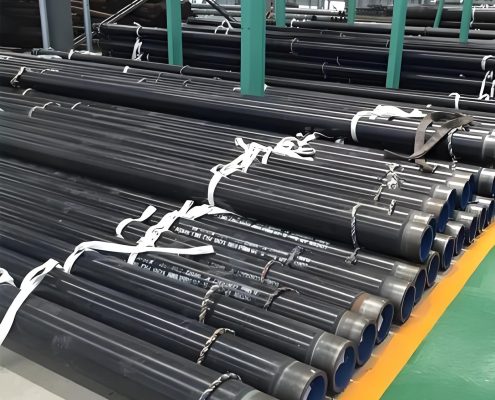Future Energy Steel’s high-quality 3LPE Coated Pipe, adhering to DIN 30670, CAN/CSA Z245.21, NF A49-721-1 or ISO 21809-1 standard, also called Three-Layer Polyethylene coated pipe, offers superior anti-corrosion protection, essential for oil, gas, and water pipelines. This coating system includes a fusion-bonded epoxy layer, a copolymer adhesive, and a polyethylene outer layer, ensuring durability and resistance to chemicals, moisture, and mechanical damage. The 3LPE coating provides excellent UV and weather resistance, making it suitable for underground and aboveground installations. With a long shelf life and minimal maintenance, it is widely used as onshore and offshore pipelines for transporting various fluids, including crude oil, refined petroleum products, natural gas, water, chemicals, and wastewater. Contact us at [email protected] to get a quotation for your project.
FAQs
What is 3LPE Coated Pipe?
3LPE (Three-Layer Polyethylene) coated pipe is a type of pipe used primarily for the transportation of liquids and gases. The coating process involves three distinct layers applied to the pipe’s exterior to enhance its performance and longevity. The three layers are:
- Epoxy Primer: The first layer is a corrosion-resistant epoxy primer that adheres to the pipe’s surface, providing a base layer that promotes adhesion of the subsequent layers.
- Polyethylene Adhesive Layer: The second layer is a polyethylene adhesive that binds the epoxy primer to the final outer layer, ensuring a strong, durable bond.
- Polyethylene Outer Layer: The third and outermost layer is a high-density polyethylene (HDPE) that provides excellent mechanical protection against external damage, corrosion, and environmental factors.
This multilayer coating system is designed to protect pipes from aggressive environmental conditions and ensure their durability over extended periods.
What Are the Advantages of 3LPE Coated Pipe?
3LPE coated pipes offer several significant advantages:
- Corrosion Resistance: The epoxy primer layer and polyethylene coating together provide excellent protection against corrosion, extending the pipe’s lifespan, especially in harsh environments.
- Mechanical Protection: The outer polyethylene layer offers robust physical protection against impact and abrasion, reducing the risk of damage during handling and installation.
- Chemical Resistance: The coating system is resistant to a wide range of chemicals, making it suitable for transporting various types of fluids and gases.
- Thermal Insulation: The coating provides thermal insulation, which can be beneficial in maintaining the temperature of the transported material.
- Low Maintenance: The durable coating reduces the need for frequent maintenance and inspections, leading to lower overall operational costs.
What Are the Applications of 3LPE Coated Pipe?
3LPE coated pipes are used in a wide range of applications due to their durability and protective qualities. Common applications include:
- Oil and Gas Pipelines: For transporting crude oil, natural gas, and refined products, especially in environments where corrosion is a concern.
- Water Supply Systems: In municipal and industrial water supply systems, where protection from environmental factors and corrosion is essential.
- Chemical Transport: For conveying chemicals and other corrosive substances in various industrial settings.
- Heating Systems: In heating systems where thermal insulation and protection from external elements are important.
- Infrastructure Projects: For use in underground and above-ground pipelines in construction and civil engineering projects.
For 3LPE Coating, is the Third Layer HDPE?
Yes, in the 3LPE coating system, the third and outermost layer is indeed high-density polyethylene (HDPE). This layer is applied over the adhesive layer and provides the final protective barrier against physical damage, abrasion, and environmental conditions.
What is the Working Temperature Range of 3LPE Coated Pipe?
The working temperature range of 3LPE coated pipes typically extends from approximately -40°C to +80°C (-40°F to +176°F). However, the exact temperature range can vary depending on the specific formulation of the coating and the manufacturer’s specifications. It is essential to consult the product data sheet or manufacturer for precise temperature limits and performance details.
Related Standard Specifications for 3LPE and 3LPP Coatings
CSA Z245.21 External Polyethylene Coating for Pipe
DIN 30670-1 Polyethylene Coatings of Steel Pipes and Fittings – Part 1: Requirements and Testings of Factory-Applied Extruded Coatings
SHELL DEP 31.40.30.31-Gen. External Polyethylene and Polypropylene Coating for Line Pipe (Amendments/Supplements to ISO 21809-1)
BP GIS 06-403 Application of Three-Layer Fusion Bonded Epoxy-Polyethylene Coating and Three-Layer Polypropylene Coating System for Line Pipe
DNV-RP-F106 Factory Applied External Pipeline Coatings for Corrosion Control
ISO 21809-1 Petroleum and Natural Gas Industries — External Coatings for Buried or Submerged Pipelines Used in Pipeline Transportation Systems – Part 1: Polyolefin coatings (3-layer PE and 3-layer PP)
IPS-G-TP-335 Material and Construction Standard for Three-Layer Polyethylene Coating System
DIN30678 Polypropylene Coatings of Steel Pipes and Fittings – Part 1: Requirements and Testings of Factory-Applied Extruded Coatings
EN 10286 Steel Tubes and Fittings for Onshore and Offshore Pipelines –External Three-layer Extruded Polypropylene Based Coatings.
09-SAMSS-114 Shop-Applied Extruded, Three-Layer Polypropylene External Coatings for Line Pipe
NF A49-721-1 Petroleum and Natural Gas Industries – External Coatings for Buried or Submerged Pipelines Used in Pipeline Transportation Systems – Part 1: Polyolefin Coatings (3-Layer PE and 3-Layer PP)

